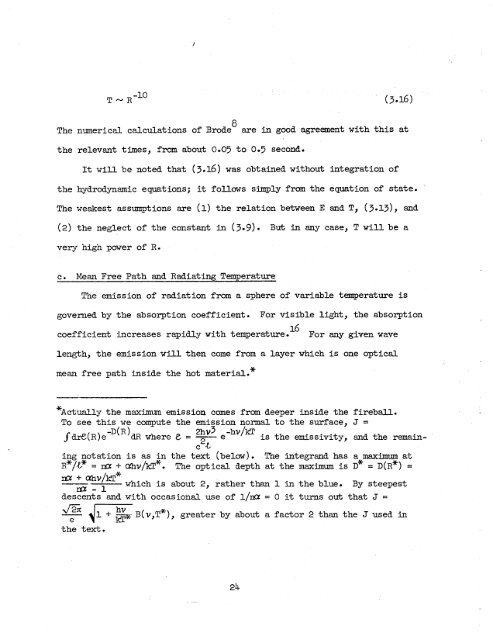Theory of the Fireball
Theory of the Fireball
Theory of the Fireball
Create successful ePaper yourself
Turn your PDF publications into a flip-book with our unique Google optimized e-Paper software.
T-R -10<br />
(3.16)<br />
8<br />
The numerical calculations <strong>of</strong> Brode are in good agreement with this at<br />
<strong>the</strong> relevant times, from about 0.05 to 0.5 second.<br />
It will be noted that (3.16) was obtained without integration <strong>of</strong><br />
<strong>the</strong> hydrodynamic equations; it follows simply from <strong>the</strong> equation <strong>of</strong> state.<br />
The weakest assumptions are (1) <strong>the</strong> relation between E and T, (3.13), and<br />
(2) <strong>the</strong> neglect <strong>of</strong> <strong>the</strong> constant in (3.9) . But in any case, T will be a<br />
very hign power <strong>of</strong> R.<br />
C. Mean Free Path and Radiating Temperature<br />
The emission <strong>of</strong> radiation from a sphere <strong>of</strong> variable temperature is<br />
governed by <strong>the</strong> absorption coefficient. For visible light, <strong>the</strong> absorption<br />
coefficient increases rapidly with temperature. For any given wave<br />
length, tine emission w ill <strong>the</strong>n come from a layer which is one optical<br />
mean free path inside <strong>the</strong> hot material.*<br />
*Actually <strong>the</strong> maximum emission comes from deeper inside <strong>the</strong> fireball.<br />
To see this we compute <strong>the</strong> ernigsion normal to <strong>the</strong> surface, J =<br />
2hv3 e -hv@<br />
jdr@(R)e -D(R)dE? where e = - is <strong>the</strong> emissivity, and <strong>the</strong> remain-<br />
C2.e<br />
ing notation is as in <strong>the</strong> text (below). The integrand has a maximum at<br />
R"/$* = a + cuhv/fl*. The optical depth at <strong>the</strong> maximum is D* = D(R*) =<br />
ncu + @nv'kir* which is about 2, ra<strong>the</strong>r than 1 in <strong>the</strong> blue. By steepest<br />
a-1<br />
descents and with occasional use <strong>of</strong> 1/m = 0 it turns out that J =<br />
e 4- B( v,T*), greater by about a factor 2 than <strong>the</strong> J used in<br />
<strong>the</strong> text.<br />
24<br />
16
















